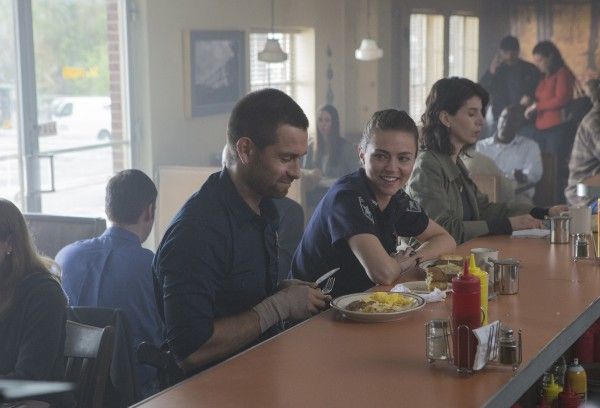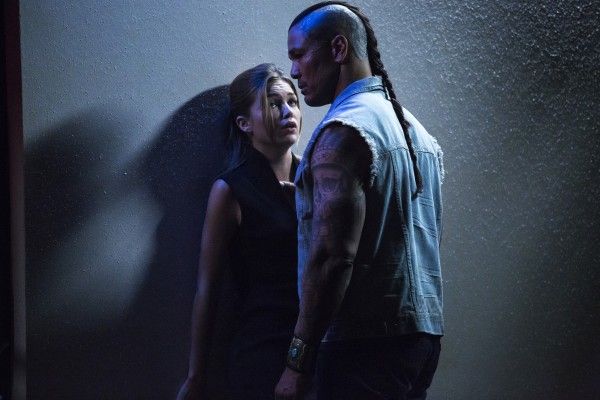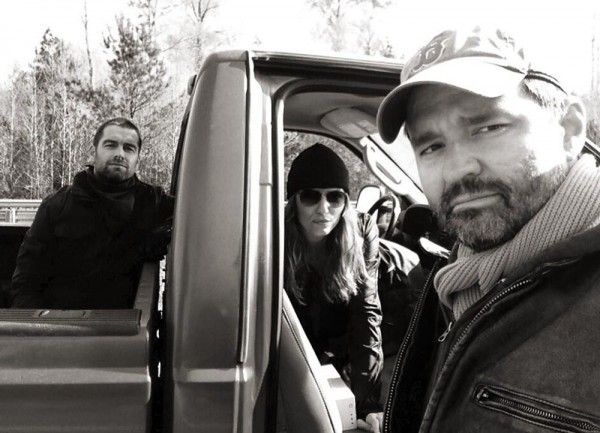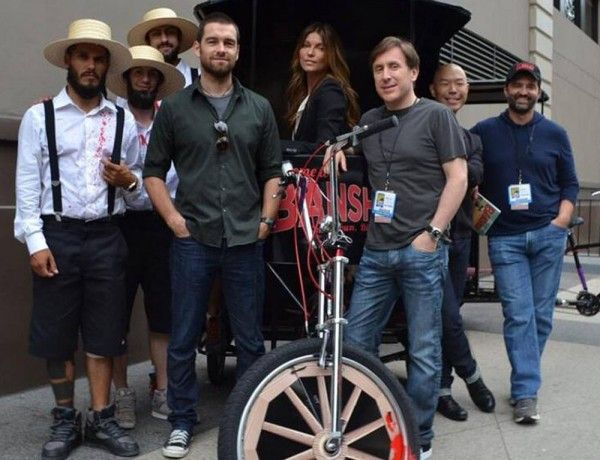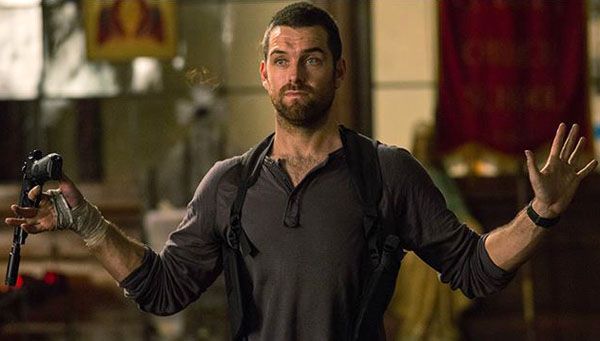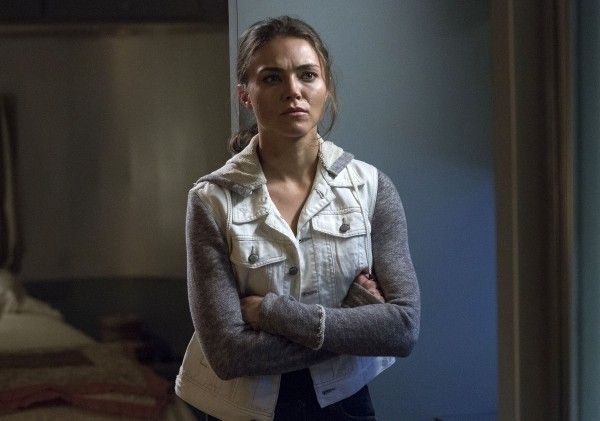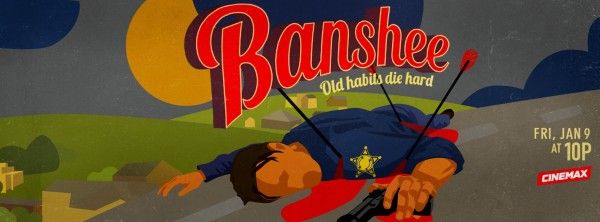The intensely violent Cinemax drama series Banshee is bolder and even more ambitious in its third season. It never backs down, it never shies away, and it’s definitely not afraid to go there. Plus, you never can predict where it’s going to go next.
During this exclusive phone interview with Collider, executive producer Greg Yaitanes talked about the inter-connectivity of the show, planting the seeds for future stories very early on, who is actually running Banshee, at this point, just how unhinged Rebecca (Lili Simmons) will get, the unexpectedness of the violence, that fight scene between Nola (Odette Annable) and Burton (Matthew Rauch), each season’s diversion episode, how what happened with Siobhan (Trieste Dunn) will affect Lucas (Antony Starr), the heist at Camp Genoa, and where things are headed next. Be aware that there are some spoilers.
Collider: The more complex and complicated that the show gets, and the more layers of characters that you keep adding, how challenging is it to keep all of those balls in the air, give everybody their due, and make sure you’re not letting anybody fall by the wayside?
GREG YAITANES: It’s funny that you put it that way. We do set out with the mentality that we are not out to give everybody their due, but to service the stories that we are telling. It’s really a matter of what bubbles up to the surface of Banshee. For example, this year, you’re seeing Brock and his story really come to the surface, and there’s a very specific reason for that. I’m very allergic to when shows feel like they have to give big storylines to very incidental characters because that person hasn’t been given a lot. That’s the wrong way to operate. This year, especially, we went into it with the theme of inter-connectivity. In the absence of Rabbit, the show is an ensemble, more than over, and it’s important that everybody touches everybody else, in one way or another. Everybody is having an intersection of some kind. Jonathan [Tropper] has always modeled the show a little bit on the structure of The Empire Strikes Back, where you never knew where you were going to go, but no matter where you were, it was great. That’s where we try to land Banshee.
This show really has no throw-away characters or moments. Everything comes back, in some way.
YAITANES: We planted the seeds of Camp Genoa in the pilot. Brock mentions that there’s a military base on the outskirts of Banshee, called camp Genoa. If you go back and look at the last few seasons, we’ve kept marines in the background and we’ve brought them to the foreground, every once in awhile. Nola beat them up last season. We want to make sure things happen organically. We’ve had a five-year plan with this. We have a long game, in terms of what we’re going to do with Banshee, and we’ve been planting the seeds of things.
At this point, who would you say is actually running Banshee, or thinks they’re running Banshee?
YAITANES: Exactly! That’s a good question because Banshee is lawless. For me, Proctor has the true control of the town. Chayton is a threat, but that’s not a threat that reaches out to every citizen of Banshee. But with Proctor’s reach, Proctor’s power and Proctor’s charisma, even though everybody knows who he is and what he does, that’s the kind of person you turn to in difficult times. That’s why a Proctor-Lucas storyline is always so compelling. There’s only room for one at the top. There can be only one, so it’s always a matter of who is on top, and they are right there, neck-and-neck, all the way to the very last minutes of the season.
Just how unhinged will Rebecca get?
YAITANES: Her arc definitely mirrors Michael Corleone, in many ways. She is really coming into the business. The most dangerous thing about Rebecca is that she doesn’t know what she doesn’t know, and that’s going to have huge consequences in the last four episodes.
As Rebecca becomes more power hungry, will that change Kai Proctor’s feelings about her and his perception of her?
YAITANES: Proctor is creating the seeds of his own destruction, by teaching her the business. I think that’s the best way to explain it.
One of the things people love about this show is the unexpectedness of the violence. How difficult is that to maintain, especially three seasons in?
YAITANES: It comes very organically. We never set out to do something big or crazy. Episode 5 was conceived to be a very contained episode, but it was probably our biggest logistical episode of the series. We just never expected that, when we got into it. Although when the machete fight was on the table, for Episode 5, there was no way that wasn’t happening. Banshee is the kind of place where a machete is in the evidence locker. That’s the only place that this could happen. There’s no other cop show where a machete could be found in the evidence locker. But, it actually comes with great ease. We have a phenomenal stunt team that we work in tandem with. We never go at the fight scenes like, “Okay, how do we top ourselves?” We always just want to tell the enjoyable, unexpected set pieces, and we try to tell them really well.
The fight scene between Odette Annable and Matthew Rauch was just incredible to watch.
YAITANES: Thank you! They trained for six weeks to do that ‘cause it was so demanding, and that was largely all them. It has the appearance of being a single shot, so it was very visually complex. It took a full day to shoot, and required weeks and weeks of planning.
Were there a lot of discussions about why those two characters and why that final outcome?
YAITANES: Two things come out of that. We do definitely talk about who we can pair up with each other. When we created Nola, and it speaks to how Jonathan and I work, I had done House with Odette and she happened to become available, toward the end of Season 1. I said to Jonathan, “Odette is available. Wouldn’t she make a great wife of Alex Longshadow?” And then, Jonathan was like, “What if she’s his sister, and she’s an assassin?” And I was like, “What if her weapon is a tomahawk?” And he was like, “Yeah!” So, we introduced her in the first season, and then we were like, “What would happen if Nola and Burton got into it? With a character like Nola, she either had to be back in Banshee full-time, and be the head of the tribe and in a power struggle with Chayton, or she had to leave again.
The great thing about the cast that we have is that they are in demand, so we never know when we’re going to be able to get certain people back, and that requires a lot of planning. Instead of it just ending, one of the touches I added and had to fight for a bit, I wanted to see a very significant moment or crossroad in their life, during that battle. I wanted it to feel like they weren’t just fighting, but they were, in a way, connected and bonded, and I also wanted to give some insight. You’ve seen a lot of fight scenes, but rarely do you get to see something like that. In the case of Burton, you see the first person that he killed. If you watch Banshee: Origins, at www.WelcomeToBanshee.com, or you stick around until later in the season, that flashback that you see in Episode 3 is going to have more context. And it was the same thing for Nola. That flashback went back to when her and Chayton first met, and how deep their bond goes. It was also a great way to represent that they were both teetering on the edge of dying, and whoever won would have won just by breathing, but not much else.
What was it like to shoot that inside of such a confined space as a car?
YAITANES: The history of that was that it actually started as a sequence where, after the attack of the Redbones at Proctor’s house in Episode 2, we were going to drain the pool and Burton was going to be hosing down the inside of the pool, and the fight was going to take place largely in the empty pool. But it was not feasible to drain the pool because, in certain parts of the country, if you drain the pool, the pool can pop out of the ground because of the water table, and we didn’t want to do that. So, we decided that it was time to retire the Rolls Royce. And then, we had this other crazy idea that the trunk of the car would have these extra weapons of Proctor’s.
My favorite moment was when he lifted the trunk and there was all of that crazy shit in Proctor’s car. That was great. We really wanted that fight to truly be between characters where either of them could go, or neither of them could go. It couldn’t be Lucas and Nola because you’d know how that would end. We wanted you not to know who was going to die, until it actually happened. It was pretty intense. I’m really proud of that work. It was a phenomenal fight and we didn’t compromise, in the least. We just went all out, all the way through, and tried to make something that emotionally resonated, as well.
You do a very interesting diversion episode each season. What’s your process for figuring out what that will be, and how you decided on the specific idea for this season?
YAITANES: My creative marriage to Jonathan is where these things really get inspired. In Season 1, when we landed on the locket having a photo of this house that he bought, I said to Jonathan, “We have to go to that house, some day.” It’s a reflection of where he’s at and his state of mind. When we were breaking the season, we saw that opportunity, and that really lead to a very emotional, very different, very quiet, no less Banshee type of episode, which expanded our vocabulary. Episode 6 of this year was born out of a conversation at Comic-Con. The original idea was that we weren’t going to explain it, and it would just be a complete anomaly in the season and we would just do a “what if” episode. Some of my favorite comics, as a kid, were when they did, “What if Spider-Man hadn’t gotten bitten by the spider?,” and they’d do a comic about what would have happened, had that not taken place. So, I was like, “What if the real Lucas Hood never died?,” and Jonathan loved that idea.
We developed an episode where you would see the Banshee that would have been, had it not happened, and you’d see how different or not different it would have been. When we decided to connect Chayton back to the season and tease him at the end of Season 2, we knew that the way that he breaks that guy’s neck would be the way that he would kill Siobhan. And then, later that fell into this imagining of what if he had never come, or what if he had left. Would she still be alive? It just worked from there. Jonathan and I are always in a riff of, “Yes, and . . .” Or we play, “Would it be cool, if . . .,” and we geek out on stuff. You have two fanboys making the show that they would love to watch. That’s why I think a lot of the stuff connects. But, it rarely ever ends up as the original idea that one of us had. It always goes through this nice back-and-forth that is probably the greatest creative shorthand that I’ve had in my career.
Was it because you knew you would be losing Siobhan that it was okay for her to find out the truth about Lucas Hood and what his real name actually is?
YAITANES: Well, once you know that that’s happening, you can do a couple of things. We resisted doing too much Back to the Future winky stuff with the “what if” episode. It is Lucas imagining that, so in theory, he could get the perfect day of Banshee all worked out, the day that he rolled into town, and leave Banshee a better place. That was the story we were telling. We did talk to Trieste [Dunn] and let her know. She is present for a majority of the season, and we told her that. And it coincides with her being at a great spot in her career and being able to grow. We were all on the team of how we were going to do this, and we worked together to give it the best result. We resisted things like Siobhan being pregnant and telling him. We tried not to put a hat on a hat and really make it too much. We also did the misdirect to have her say, flat out, “I don’t want to die tonight.” Therefore, you would think that would somehow protect her, but in fact, it did not.
What was it like to shoot that scene, when everybody knows they’re essentially losing a member of their TV family? Do you feel the weight of something like that?
YAITANES: Because we shoot out of sequence, often when people wrap the season or are wrapped out of the show, it’s rarely the scene where they’re dying. It’s always the hardest conversation to have. I say it not to sound callous, but you really try to do what’s best for the show. If it was best for the show for me not to be there, I wouldn’t be there. This is where the story is going, and this is what the show needs. And everybody knows the kind of show this is. Anytime we do send anybody out, they get a great episode out of it, as well as consequences. Emmett’s death, last year, paid off this year. It’s had rippling effects. We don’t do it just to do it, ever. Although, the mayor in Season 1 was not our finest moment, but that was just a function of that character not really working.
Where are things headed now, for the rest of the season?
YAITANES: When we deal with it, in the season, is as unexpected as how we deal with it. We have season finale type of moments happening, all throughout the rest of the year. Chayton’s resolution may come sooner than the end of the season. The hunt for Chayton is going to occupy Lucas’ obsession. And the heist sequence is probably the thing that, personally since I directed it, I’m phenomenally proud of how we executed it.
Banshee airs on Friday nights on Cinemax.


